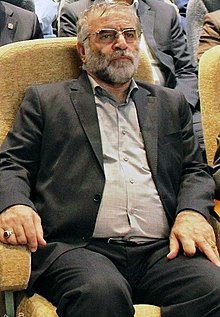From LA Progressive
How Israel deployed an intelligence deception to justify killing scientist Mohsen Fakhrizadeh
Mohsen Fakhrizadeh.
(Image by Wikipedia (commons.wikimedia.org), Author: tasnimnews.com) Details Source DMCA
The Israeli assassination of Iranian defense official Fakhrizadeh is being treated as a triumph of Israeli intelligence, with ubiquitous references in the New York Times and other major media outlets to the killing of "Iran's top nuclear scientist." In fact, Israel's Mossad intelligence agency eliminated Fakhrizadeh, a defense official, despite the knowledge that its public depiction of him as the key architect of an Iranian nuclear weapons program was a deception.
For years, US media outlets have portrayed Fakhrizadeh as Iran's equivalent to J. Robert Oppenheimer, marketing him to the public as the mastermind behind an Iranian version of the Manhattan Project. This image was developed primarily through a carefully constructed Israeli disinformation operation based on documents that displayed signs of fabrication.
The origin of the Mossad propaganda operation on Fakhrizadeh lies in the early 1990's, when the US and Israel first developed suspicions of Iranian ambitions to develop a nuclear weapon. U.S., British, German and Israeli intelligence analysts had intercepted telexes from Sharif University about various "dual use" technologies -- those that could be exploited in a nuclear program but also be applied for non-nuclear use.
Many of the telexes contained the number of an organization called Physics Research Center that operated under the watch of Iran's Defense Ministry. The CIA and its allied intelligence agencies interpreted those intercepts as evidence that the Iranian military was running its own nuclear program, and thus that Iran was covertly seeking a nuclear weapons capability.
During the first term of the George W. Bush administration, the notorious militarist and Likud ally John Bolton took charge of Iran policy, prompting the CIA to issue an estimate concluding for the first time that Iran had initiated a nuclear weapons program. Israel's Mossad apparently saw Washington's new posture as a green light to set into motion a black propaganda campaign to dramatize and personalize the secret Iranian nuclear weapons program that was presumed to exist.
Between 2003 and 2004, Mossad produced a large cache of alleged Iranian documents depicting efforts to make a nuclear weapon with Iran's Shahab-3 missile and a bench system to convert uranium.
The Mossad files contained multiple tell-tale signs of forgery. For example, the reentry vehicle depicted in the drawings had already been abandoned by 2002 -- before these drawings were supposedly created, according to the documents themselves -- in favor of a design that looked entirely different and which was first shown in an August 2004 test. So whoever was responsible for the drawings was clearly unaware of the single most important Defense Ministry decision affecting the future of Iran's missile deterrent.
The CIA never revealed who spirited the documents out of Iran or how. However, former senior German Foreign Office official Karsten Voigt explained to this reporter in 2013 that the German intelligence agency, the BND, had been furnished with the collection by an occasional source whom the intel chiefs considered less than credible.
And who was this source? According to Voigt, he belonged to the Mujahedeen e-Khalq (MEK), the exile Iranian cult which had fought for Saddam's Iraqi forces against Iran during the eight-year war and by the early 1990s was passing information and propaganda that Mossad did not want to have attributed to itself.
Painting Fakrhizadeh as nuclear mastermindThose Mossad documents identified Mohsen Fakhrizadeh as the manager of a supposedly top-secret Iranian project called the "AMAD Plan." In reality, Fakhrizadeh was an Islamic Revolutionary Guard Corps officer and official in the Ministry of Defense Armed Forces Logistics (MODAFL), who also taught Physics at Imam Hussein University in Tehran.
To implicate him as a nuclear project mastermind, the collection of Mossad documents featured a directive supposedly signed by Fakhrizadeh. But since no one outside Iran had ever seen the previously obscure official's signature, and given the lack of effort to show any official government markings on the documents, there was little to prevent Mossad from forging it.
In their 2012 history of Israel's intelligence service, "Mossad: The Greatest Missions of the Israeli Secret Service," Michael Bar-Zohar and Nisham Mishal pointed to Mossad as the culprit behind the appearance of the supposed Iranian nuclear documents. The writers recounted how Mossad gathered the personal information on Fakhrizadeh that was later released to the public through the MEK, including his passport number and his home telephone number.
"This abundance of detail and means of transmission," Bar-Zohar and Mishal wrote, "leads one to believe that...'a certain secret service' ever suspected by the West of pursuing its own agenda, painstakingly collected these facts and figures about the Iranian scientist and passed them on to the Iranian resistance [MEK]."
The documents also fingered Fakhrizadeh as the former head of the Physics Research Centre, thus deceptively linking him to the procurement efforts for "dual use" nuclear items in 1990-91 that were well known to CIA and other intelligence agencies. That accusation was reflected in the 2006 United Nations Security Council Resolution 1747 listing Iranian officials responsible for nuclear and missile proliferation in Iran. In the UN resolution, Fakhrizadeh was identified as a "[s]enior MODAFL scientist and former head of the Physics Research Centre (PHRC)."
(Note: You can view every article as one long page if you sign up as an Advocate Member, or higher).





